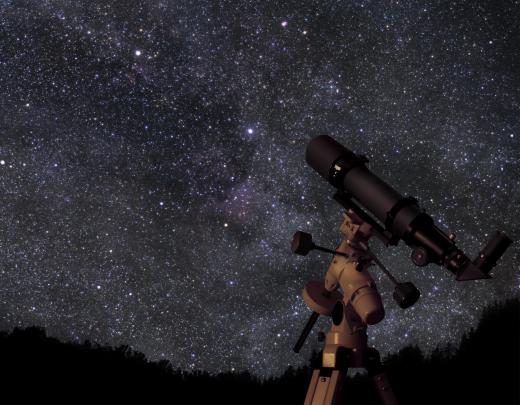What Are Cepheid Variables?
In astronomy, Cepheid variables are variable stars whose brightness changes over a certain period in a characteristic, regular way. Normally, the outward pressure from nuclear fusion in a star’s center is balanced by inward pressure due to the star’s gravity and the star remains at a constant size and brightness. Variable stars go through a cycle of expansion and contraction that affects their brightness. In Cepheid variables, the length of the cycle increases with the brightness of the star in a predictable way, so that when the period is measured, astronomers can tell the actual brightness of the Cepheid, and from its apparent brightness on Earth, calculate how distant it is. These variable stars are an important tool for measuring the distances to other galaxies.
It is thought that these stars expand and contract in a regular cycle because of the properties of helium, which they contain in large amounts. When helium is fully ionized, it is less transparent to electromagnetic radiation, causing it to heat up and expand. As it expands, it cools and becomes less ionized, absorbing less heat and contracting. This results in a regular pattern of expansion and contraction, with parallel variations in brightness, having a period ranging from one to about 50 days.

There are two main types of Cepheid variables. Type I, or Classical Cepheids, are relatively young, highly luminous stars, containing a relatively large proportion of heavier elements, indicating that they formed in regions where these elements were created by the supernova explosions of older stars. Type II Cepheids are older, less luminous stars that are low in heavy elements. There are also Anomalous Cepheids, which have more complex cycles, and Dwarf Cepheids. Classical Cepheids, because of their greater luminosity and simple, regular cycles, are more useful to astronomers for determining galactic distances.

The regular variations in brightness and the fixed relationship between brightness and cycle length were discovered by the astronomer Henrietta Leavitt in 1908 when she was studying these stars in the Small Magellanic Cloud, a small galaxy close to our own. The term Cepheid variables comes from one of the stars studied by Leavitt, called delta Cephei. Since it was possible to determine the actual brightness of a Cepheid variable from its period, it was also possible to determine its distance from the fact that the amount of light reaching Earth is inversely proportional to the distance to the source. Such objects of known brightness are known as “standard candles.”
Comparison of the results of these calculations for Cepheid variables within our own galaxy with distances calculated by parallax confirmed that the method worked. Type I Cepheids are up to 100,000 times as bright as the Sun. This means that they can be detected, by telescopes based on the Earth, in other galaxies up to about 13 million light years away. The Hubble space telescope was able to detect these stars at a distance of 56 million light years. Cepheid variables provided confirmation, early in the 20th century, that the universe extended well beyond our own galaxy, which was only one of many.
These stars also provided the first strong evidence that the universe is expanding. In 1929, Edwin Hubble compared measurements of the distances to a number of galaxies, obtained using Cepheid variables, and redshift measurements, which indicated how fast they were receding from us. The results showed that the velocities at which the galaxies were receding was proportional to their distance, and led to the formulation of Hubble’s Law.
AS FEATURED ON:
AS FEATURED ON:












Discuss this Article
Post your comments